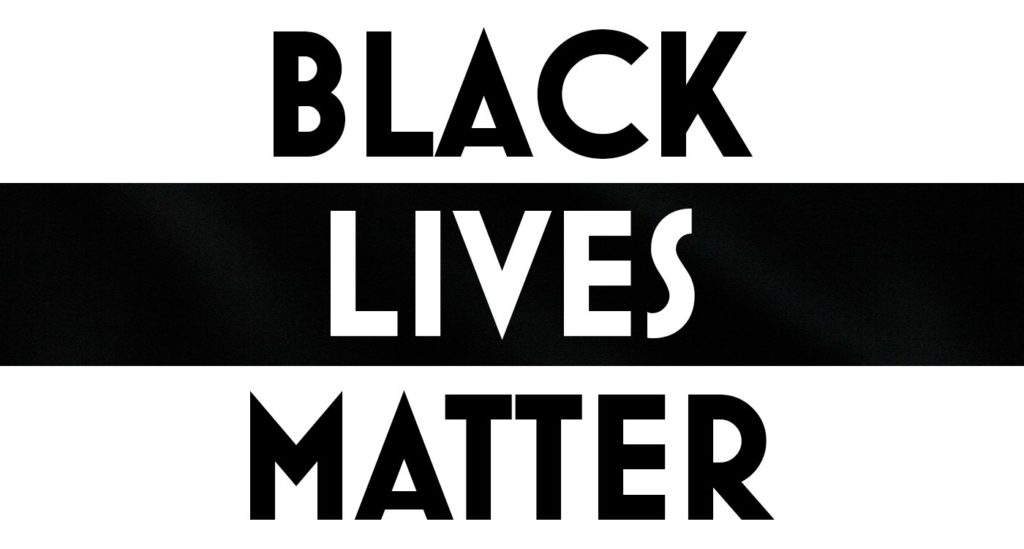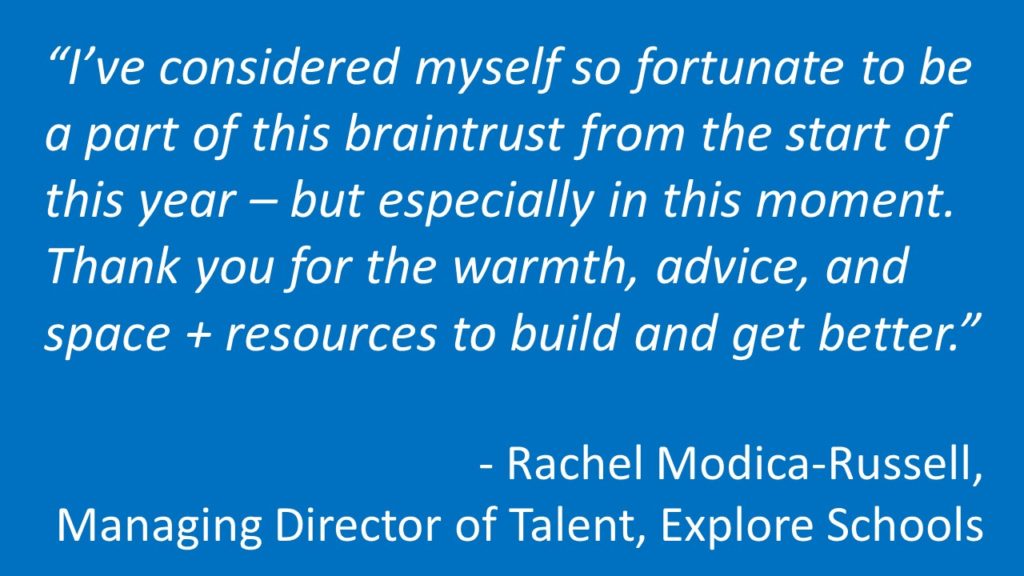Posts by Hendy Avenue
Black Lives Matter.
Our Hendy Avenue team supports the Black Lives Matter movement and condemns all acts of racism. We commit to continuing our own growth and learning as individuals and as a team. We commit to elevating the voices of our colleagues of color. We commit to loudly speaking out against racism. We commit to deepening our understanding of how the human capital systems we help to design and implement can either support or hurt both staff and students of color. We commit to creating spaces for education leaders where they can bring their full selves and safely speak their truth.
As educators, we have a responsibility not just for reading, writing, and arithmetic. We have a responsibility to help shape a better tomorrow. Breaking down racism and white supremacy culture is not parallel to the work of education, it is the work.
Leaders, It’s Okay to Take Off the Cape
Leadership is difficult in good times. In times of crisis, this difficulty grows exponentially. This notion has become even more clear through my work supporting a Chief-level leader through the restructuring of a network of schools. This leader’s plate was full before the COVID crisis hit, and their responsibility and leadership scope has essentially doubled as a result of COVID: becoming responsible for orchestrating the network’s response to the abrupt closure of schools, and most significantly designing and implementing virtual instruction. Daily they are responding to questions and concerns from families, teachers, staff, and principals, and are looked to by staff to both assuage fears and set a concrete vision and plan for next steps.
My client reflected on having to spend all of their time being “on.” Conference call after call, zoom meeting after meeting, this leader has to be the one with all the answers, or the plan to find the answers. Staff call them for advice and support, or to complain about the way other team members are responding. And my client has to be there to listen, console and plan. All day, every day.
Yes, great leaders provide security and vision to their teams to manage through crises, but fulfilling that role is incredibly draining. Last week, my client and I reflected on how nice it is for them to have a chance to “take off the cape” during our check-ins: to not have to have all the answers, to be able to complain about how difficult all of this is, and to express disappointment, fear and anger honestly. I was honored that my client saw our check-in as the time for them to take that guard down and to be able to react to and reflect on how the work was weighing on them. It also provided an opportunity for us to brainstorm ways that we can handle the burden of leadership to meet the needs of staff without burning out.
I also saw this as a reflection of what we at Hendy pride ourselves on: walking arm-in-arm with our clients as they design solutions and create programs to better serve teachers and kids. Sometimes that relationship means gently pushing our clients to do something differently; other times it means accelerating full speed ahead on executing a plan. In these crazy times, it has sometimes meant simply providing a space for our clients to “take off their capes”, to reflect honestly about the difficulties of being a leader in crisis, and to know that leading others requires us to take care of ourselves.
-Jess
Don’t You Want to Stay? Virtual Stay Conversations as Key Teacher Retention Strategy
Teacher and staff retention is a common concern we hear from school leaders in “normal” times. One of the most efficient and lowest cost methods we have found for encouraging great teachers to stay is by holding “stay conversations”. A stay conversation is an informal chance to share how much you appreciate a teacher’s work, and to directly ask them to stay at your school for the following school year. Stay conversations don’t take much effort, but they have a big impact. When teachers were asked why they left their school, a common response was simply that no one asked them to stay.*
A stay conversation usually happens in a regularly scheduled one-on-one meeting with the teacher. Stay conversations should begin early in the year, ideally before winter break. Leaders can and should continue to communicate value and priority to teachers throughout the spring. This way, if teachers are presented with an opportunity to leave their school, they know how much they are valued and are less likely to leave.
That’s how stay conversations might proceed in normal times. These, however, are not “normal” times. The challenge and uncertainty of the pandemic makes retaining teachers even more critical. Just because we are all working virtually, leaders should not stop holding stay conversations. In fact, the best practices for stay conversations still apply: keep the conversation brief, affirm how much you value the teacher, and articulate how important they are to your students and school. Be honest about the challenges of remote teaching and uncertainty of what the fall might look like. Then share why the teacher is an important part of the team, especially in this uncertainty. Strong teachers are providing a lifeline to families and students right now, and they will continue to need your great teachers when school restarts in the fall. Finally, ask the teacher directly to stay at your school next year.
Ideally you are touching base with each teacher individually on a regular basis during this time of remote teaching and learning. These one-on-ones can be quick check-ins to ask the teacher how things are going for them, and how you can support them. And they are a great time to say directly how much you value the teacher’s work, and ask them to stay next fall.
P.S. If you need a soundtrack to your stay conversations, try this pop, or R&B, or classic rock, or country, or early 90s style (my personal favorite)!
-Jessica
*From The Irreplaceables, TNTP, 2012.
Celebrating Teacher Appreciation Week 2020
Early May is one of our favorite times of the year. The weather warms, flowers bloom, and teachers are celebrated for an entire week! While we think teachers (and leaders) should be recognized everyday for their tremendous work, Teacher Appreciation Week, this year from May 4 – May 8, is a nice formal opportunity to say thank you.
Though we are teaching, learning, and working virtually, here are 7 ideas for celebrating teachers:
- Send a personal note. More than ever, teachers are inundated with emails and texts. A personal note – sent via the old fashioned, but dependable USPS – can go far for anyone, including your teachers.
- Give a gift. Sometimes, someone taking care of the dinner that night is all you need to make it peacefully to tomorrow. Gift cards, meals from local restaurants, and gift certificates to local businesses are always appreciated. Even a small plant left on the teacher’s doorstep to “decorate their home office” is a meaningful way to say thanks.
- Give time. For leaders, consider cancelling a regular staff meeting and encouraging teachers to use the “found time” to do something for themselves.
- Get families to engage. Ask families to record a short video clip, write notes of appreciation or text pictures of homemade thank you cards.
- Party in a box. Put together a small package of party supplies–balloons, sunglasses, streamers, candy, and a small gift or two–and mail it to each teacher with a label on the outside directing them not to open until a certain date and time. During a staff meeting, have everyone open their boxes simultaneously and start the party!
- Opportunities for input. For some, the greatest recognition is the opportunity to be heard and enhance their impact. Think of ways to bring teachers into decisions–about curriculum, schedules, virtual learning and more.
- Shout-outs. While you may not be physically together, shouting out teachers in meetings, emails, and on social media/websites is a simple, but effective method for letting folks know you value and appreciate them, and a great way to highlight the values you most want your team to exemplify.
Yes, You Can Stop Doing That
Before COVID-19, education leaders prided ourselves in being goal oriented professionals, doing everything in our power to support student success. Working in schools, districts, CMOs, state departments of education and in supporting organizations, we took pride in our commitment to do whatever it takes, knocking through barriers, and always maintaining high expectations for ourselves and others.
But now, that day is over. Or at least on pause. We are balancing full days of meetings with full days of homeschooling our own children, we are nursing ourselves or our families back to health, we are facing fear, frustration, and grief. Our lives have changed and so too must our expectations for ourselves and for others.
Talking with talent leaders across the country, We’re discovering that many simply need to hear, “You can stop doing that. It will be ok.” It’s time to re-prioritize and focus on the purpose of your work, not stay wed to the original plan or program. Schools can be our model. Teachers and principals are learning a whole new way to educate students. They are no longer teaching the same lesson plan, but they are working toward the same standards, ensuring that students are able to learn and grow. District and network leaders need to do the same.
For example, we were recently asked by talent leaders in both a big urban district and in a big charter network about how to continue their robust evaluation systems. While we firmly believe in systems of teacher development, evaluation, recognition and pathways (and have spent most of my career focused on them), now is the time to pause and reassess. It’s the time to ask yourself what the ultimate purpose of your work is and if your system is doing that now. It’s time to simplify and focus on achieving that original purpose, not to MacGyver a complicated and time consuming process. When we talked with leaders about their multiple measure evaluation systems we were direct – your student achievement measures based on interim data aren’t going to be accurate and won’t help teachers get better, so don’t do that. Your families don’t have time to give feedback on teachers, so don’t do that. Your teachers aren’t teaching in ways that align to the observation rubric and had to learn this new method in a day, so don’t do that. Instead, coach and support the adults to do the best they can in a tough situation so they can be their best for kids.
The purpose is always to support people to get better and stay longer.
Is your system doing that now?
As a talent leader, we recommend focusing your time and energy into five priorities:
- Communicate clearly and transparently – State what you know and what you don’t yet know. Be clear about the values that are driving decisions and what is being prioritized right now. Be real about your own fears and your own optimism. And find ways to connect. You can share a video, hold office hours or reach out one on one. In doing so, always focus on the employee’s needs as a person.
- Listen to and support your school leaders – School leaders are struggling through this time, navigating their own emotions and disappointments, and those of their teachers, students and families. Be responsive to their needs and make them your priority. When you need their input, make it as easy as possible for them. Give them a clear proposal and let them react.
- Retain your staff – Have “stay conversations” so people know they are valued and appreciated. Ask them directly through conversations or surveys what their plans are for the fall. Consider how to retain salaries through limited budgets and how to incentivize people through non-monetary compensation.
- Recruit and hire new candidates – Hiring will need to move online, but keep the process moving. Think about how to get hiring managers comfortable granting offers remotely and how to get candidates comfortable to accept offers. Identify how to bring your schools’ unique culture to candidates. For more, check out TNTP’s Virtual Hiring Guide and Fast Company’s article on unconscious bias.
- Recognize and celebrate people – Consider cancelling performance based rewards based on results from 2019-2020 and re-use these funds to recognize teachers now (or returning teachers in the fall). Identify ways to say thank you for the hard work and creativity people are bringing to the work. For example, a personal thank you message, a take-out restaurant gift certificate or a retention bonus at the start of next school year are all effective in letting people know they are appreciated.
As our fearless talent leaders, we want to say thank you for taking care of the adults so they can take care of the children. And, yes, you can stop doing that.
Consulting in the Time of Corona
We are all adjusting. For some, it’s a shift to full-time work from home; for others it’s becoming first-time teachers helping their children stay on track while out of school, whether it be modeling the concept of multiplication with blocks or explaining how the ghost in Hamlet provides examples of foreshadowing; others are essential workers adjusting to added spotlight and stress during the COVID crisis.
And then, there are those who are sick themselves. For almost three weeks in March, this was me. It started with a couple days feeling a bit more tired than usual, but soon turned into a high fever, full body aches, exhaustion, ongoing chills and night sweats. Once the fever broke after four days, I remained exhausted and developed chest tightness and a persistent, dry cough. Around day 13, after watching four seasons of The Sopranos, two seasons of The Great British Baking Show, and of course, Tiger King, I started to feel more like myself, but the cough lingered. I inched back to work, having been completely detached from my computer, let alone clients, the entire time. Finally, at three weeks, I had no symptoms, was back to work fully and celebrated, feeling truly thankful that I never had breathing difficulty or required hospitalization.
I share these less than fun symptoms for the sole reason of letting others know that they are not alone. The virus is rough–my case was “mild”–and takes a long time to clear; but don’t lose faith on day 7 and of course, keep in touch with your doctor regularly to plan your care.
Reflecting on my experience produced a few cliche-heavy reminders for me, that may be helpful to consider if you are ill or caring for a sick loved-one.
- Put your oxygen mask on first. I was completely wiped out and felt physically terrible and emotionally defeated. I hate not feeling productive, am terrible at asking for help, and miserable being dependent on others; but my reality required I not only stop working, managing meals, and walking the dog, but prioritize recovering above all else and accept that it was 100% okay to do so. I had to tell myself, “I will be better for it and my work will be better for it”.
- Communicate. When sick, we often rely on the help of loved-ones around us. Remember: they can’t read your mind. You have to communicate your feelings and needs, and they have to ask a lot of questions to care for you. Be direct, but kind, remember that everyone is stressed and living in uncertainty. Worry shows itself in lots of ways, so give everyone in your life a bit of grace. Be honest with people about the type and frequency of communication. If you want a text message from your 5 best friends each day, let them know how much it means when they check in. If you don’t want to have your phone buzzing all night, let the frequent callers in your life know the schedule you’re trying to keep and when you plan to next reach out.
- Have a plan. Dealing with any illness is stressful, but COVID-19 in particular is new with little scientific study and a tendency to change in intensity quite quickly. I recommend having a plan in place for any potential escalation of symptoms. Specifically, know what hospital/clinic you will go to and how, list who you will contact, plan for any child or pet-care implications, and have already-packed overnight bags by the door.
- Go slow to go fast. Once I started to feel well, I wanted life to immediately return to normal; I longed for the sense of accomplishment from completing a task, a mid-day bike-ride through Prospect Park, a nice dinner with a glass of red wine. I had these dreams, while simultaneously barely able to make it through the day without a 3 hour nap. To those of you sick or recovering, go slow and be kind to yourself. No, things will not be “normal” for a while, but the more you honor your physical and emotional needs now, the sooner you’ll be back to feeling like yourself.
-Grant
Principals and teachers are supporting kids. Who is supporting the principals and teachers?
All across our country, school systems are scrambling to re-invent education. Our school, district and state-level leaders are working to ensure that their families and students are safe. School staff is hustling to make sure that their students have their basic needs met, while simultaneously inventing systems for distance learning. Committed school leaders and teachers, as usual, are laser-focused on supporting families and preserving learning. But who is focused on the grown-ups? Who is orienting themselves towards this whole new way of working?
Remote work and distance learning have thrown a huge curveball at the talent/HR world and, besides ensuring safety and learning, arguably the next most important thing for school systems is to figure how to support and manage a remote workforce (particularly one that has happened in person up until now!). Talent leaders and management teams across the education sector are working to figure things out within their organizations in just a matter of days. It’s enough to make your head spin. I don’t know about you but when a crisis like this happens I can sometimes be guilty of putting my head down like a running back and charging through the problems. I did this during 9/11 and during Hurricane Sandy. This time it’s different, the event is not happening in a day, a week, its looks like it will last months. Putting your head down and charging through might work for a while but this needs to be a heads-up and collaborative effort.
I have the great fortune to be the facilitator for a New York City-based Chief Talent Officer cohort called the “CTO Braintrust”. It’s is a small group of six talent heads from various CMO’s in NYC founded two years ago by Hendy Avenue Consulting with the belief that effective leaders need professional communities of trusted colleagues, where they can learn and grow together. The group functions as a collaborative cohort to share best practices and problem-solve on topics like DE&I, compensation, succession planning, leadership development, performance evaluation, and more. Up until a few weeks ago we met about once a month. Our cohort members have valued a space to collaborate with others wrestling with similar challenges and the group has become a tight-knit community and a trusted soundboard.
Since schools across NYC closed, the CTO cohort has relied on each other more than ever. The group has been coming together weekly and emailing almost daily to support each other in solving the myriad challenges that are facing schools and networks right now. We have been tackling all sorts of questions of various shapes and sizes:
- “What are best practices for remote management?”
- “What will we do about annual reviews if schools stay closed? Can we evaluate remote instruction?”
- “How can we support employee well being in the time of a crisis as they attend to the needs of kids and families?”
- “How can we adjust our policies around sick days to give grace to our employees when they or a family member fall ill to the virus?”
- “How do we interview and hire remotely?”
- “How does the closure impact our performance management?”
- “How are we now thinking about our budgets and compensation?”
- “Can you really just cancel spring break?”
There are thousands of other questions that we are tackling and every time it feels like it is just too much to handle, all I do is remind myself that I am going to be able to reach out to this talented and supportive group of people for help. Some folks have been “lifting up” the beauty within this crisis and sharing the strength of the human spirit and I couldn’t think of a better group to highlight than the CTO Braintrust that all at one time is supporting their network of schools, supporting their own friends and families and supporting each other. There really is something about working together to help endure a crisis. Teamwork makes the dream work, but it also helps get us through nightmares.
-Jeremy
5 Recommendations for Productive Video Conferences
As we collectively respond to COVID-19, many of our desks, classrooms, and conference tables are making way for virtual meeting spaces (Google Hangouts, Facetime calls, Zoom, Microsoft Teams, etc.) that are convenient, relatively easy-to-use and a great avenue for connecting with colleagues. That being said, not all video conferences are equally effective and efficient.
As a virtual-organization, we spend countless hours internally and with clients on video calls. Here are 5 suggestions from our team to ensure your experience is positive.
- Mute your phone! No really, MUTE. YOUR. PHONE. Even if your space is “quiet”, phone and computer microphones pick up tons of ambient noise–let alone the dog barking in the room over and the fire truck sirens whizzing by outside. Muting your phone can also help reduce audio feedback, which our eardrums appreciate! The same is true for typing! If you’re typing on your laptop during a meeting, banging really hard on the keys can end up being really loud. If you’re a key-banger (no shame!), consider hand-writing notes.
- Prep & Set the Stage. Folks understand that for most of us, working from home doesn’t allow working from a physical office. You may be in a bedroom, living room, closet, garage or if lucky enough, outside on a patio! No matter where, be sure to test your wifi signal, check that your computer is charged and test the visual background and lighting. Be sure to look at yourself on camera and clean up what’s behind you that could be distracting and/or not part of a professional work space. Have you spent countless hours tasting whiskeys from around the world to build the perfect home bar? Cool! But don’t have that behind you when video chatting with your 10th grade English class. Also be sure to test that folks can see you on the screen in full lighting, without any weird halos, shadows or distracting reflections. It can help to have a lamp in front of you, vs. behind or above you.
- Plan Ahead. As for IRL meetings (“In Real Life” as the kids say), all online meetings should have a clear agenda and objectives. When meeting virtually, it’s incredibly valuable for those items to be shared ahead of time, along with any handouts or materials that participants may need to reference or would like to print. Certain virtual meeting software programs are less friendly to viewing multiple items on the same screen at the same time, so be prepared for slower review of documents and potential logistics troubleshooting. We recommend having a named facilitator to guide the meeting and a different person as note-taker who can send a detailed wrap-up email afterwards with notes and next steps.
- Intentionally Welcome. Ever the first person to call into a meeting and worry if you’re in the right place at the right time? Meeting leaders can avoid this worry for participants by posting a “landing page” slide–something up on the screen when folks dial-in that says what the meeting is, when the meeting will start and a reminder of any materials that are needed. Since virtual meetings feel different than in-person interactions, try starting with a short “Do Now” activity or ice-breaker to get participants engaging with one another prior to starting formal meeting content.
- Practice. If you haven’t done many virtual meetings, it pays to spend some time practicing by yourself or better yet with a friend or close colleague. Through practicing, you can fine-tune key messages, test logistics and reflect upon your own style and online demeanor. One of our colleagues for example received feedback that they look “stressed” when taking notes on the computer, so they’ve switched to handwritten notes. We’re big fans of using Google docs for live collaboration, but that too requires practice to ensure folks have clear directions and high engagement.
6 Tips for Working from Home
We are in uncertain and stressful times. As the world focuses on slowing the spread of COVID-19, life at home doesn’t stop; and in many cases, is even more challenging than ever as we prioritize the health of our families, care for children home from school, co-work with spouses, remotely engage with colleagues and care for communities on the edge.
While we can’t speak to the overwhelming unrest and anxiety this pandemic is bringing into our lives, we can hopefully help in a small way, by sharing tips on how to work home. Collectively, our team has worked remotely for 20+ years and found the following concepts to be helpful. We encourage you to read below, rest up, stay healthy and care for one another.
Best,
Sarah, Grant, Jessica & Jeremy
- Make a schedule and stick to it. In normal circumstances, we’re big fans of using our calendars to block meetings, calls, work-time, and personal appointments. When at home, especially when it’s not the norm, it’s even more important to build a routine and follow-it. Plan out when you’ll review the quarterly report, check-in with a colleague and take a break for lunch. Distractions are everywhere (suggestion: turn off social media notifications), so be purposeful in spending your time “at work”.
- Start strong. Spending the day working remotely is not the same as that one magical snow day you had in 3rd grade. It can be difficult to differentiate “work-days” from other days when all are spent at home. The solution, set an alarm for the same time each day, take a shower, get dressed and “go to work”. No, you don’t need to throw on that power suit, but avoid wearing your fluffy bunny PJs on a conference call with your boss. How you dress and structure your morning can put you in the right mindset to have a productive day. Similarly, be intentional to log off at the end of the day. While we can check email on our phones, it’s healthy and important to disconnect–allow yourself to fully be present with family, call a friend, dive into a good book or binge watch a trashy tv show.
- Create space. If possible, designate a space for work that you can consistently return to, and then equally important, avoid during non-work time. This is hard for those of us in cramped spaces (hello NYC friends!), but even designating a slice of your dining room table to “work” can help create physical and emotional space between work and the rest of your life. Treat your space like you would your desk at work; keep your favorite snacks or hand lotion in the drawer, put a plant on the surface.
- Stay out of the kitchen. You’re not hungry, you’re bored. Trying having a glass of water.
- Take breaks. If you’re used to working in an office, you may not realize how often you get up, move, and walk during the day. Trips to the water cooler, meetings in conference rooms, and lunches at the corner deli all give you a mental and physical break. Without those natural touchpoints, working from home can lead to long hours in one spot. Not only is this rough on the body, your brain needs chances to reset. Add to your calendar or set a timer reminding you to stand up frequently and take breaks from screens. Try a free Pomodoro system app to remind you to take short breaks. Go for a walk, water the plants, complete a 5 minute workout routine, have a dance party, play with the dog, mediate–whatever you need to recharge.
- Communicate your schedule. Even if this is not your first foray into working from home, it may be the first time there are others in the house while you do so. If others are around (partner, kids, etc.) make sure that they know when you’re available to them, and when you’re not. Something as simple as door open, I’m available, door closed, I’m not. This can help minimize distractions
Interested in learning more, check out these articles from Gallup: Remote Teams & Managing Isolation.
From Puzzling to Problem Solving: My Growth Over Five Years at Hendy Avenue
My history with Hendy Avenue Consulting began at a coffee shop on the Lower East Side one afternoon in late 2014. I didn’t know what to expect, but thought it would be great to reconnect with Sarah, share a bit about what I had been up to professionally, hear about her work starting a consulting business and maybe, just maybe, start a conversation about how I could fit in the picture.
I couldn’t have imagined what was to come: five years at Hendy Avenue made up of great client partnerships, numerous high-impact projects impacting thousands of teachers, leaders and students, hundreds of hours video-conferencing, and a growing and tremendous team of colleagues and friends. We’ve built something special, and I couldn’t be more proud.
I’m so fortunate to work in an environment that not only supports professional (and personal) growth, but prioritizes it. It’s hard to narrow down, but here are four big lessons I’ve learned during my time at Hendy these last five years.
1. Take a Breath & Think
Prior to joining Hendy Avenue, my professional responsibilities consisted mostly of doing, rather than thinking. That’s not to say I did my work mindlessly, rather the focus and value-add of my contributions were grounded in producing materials, knocking things off a to-do list, and frankly working longer and harder than others. This efficiency-focused reality served me well in prior roles as a teacher and district administrator and during both stints in graduate school while working full-time. I thrived putting out fires and meeting tight deadlines–it was energizing. And look, I still love making and completing to-do lists, but the hyper-focus on efficiency limited the depth of my understanding of the tasks at hand, the quality of the ultimate end products, and the legacy of my work once I had moved on.
Now, as a more mature professional and seasoned consultant, I’ve retrained myself to take a breath and prioritize thinking as the real work, and as a result, my work is better, clients are happier and the impact on leaders, teachers and students is greater. Please know that This. Was. Not. Easy. (Sidenote: It’s still not easy). I was the archetype of young, type-A, overachieving, borderline obsessive, complete the task and your feelings be damned worker-bee. My own self-worth and value were tied-up in finishing the job. In fact, I remember early on into the role at Hendy just sitting at my desk with what felt like NOTHING to do. My inner-monologue wasn’t pretty: “I’m a waste. What value am I providing? Am I really doing anything to better serve students?”.
With time, and lots of other quiet moments, this role has shown me that yes, sometimes you need to put out that fire, but more often than not, we are brought into work precisely for our thinking, for our fresh and focused take on things made possible by the time and space we have as outsiders to pause, breathe, and think. When you’re treading water to stay afloat, you’re not best positioned to survey the ocean to find the route to safety. From the shore, surveying all that you can, the path becomes clearer.
I know now that my value-add is not just additional capacity–it’s asking tough questions, aggregating data, absorbing information, drawing from experience, guiding decision-making and making strong recommendations precisely because I intentionally hold sacred time and space to be strategic. So what can you do? Block time in your calendar for strategic planning/problem solving, journal or record a voice note of your questions and theories of the case, work with partners to pressure test ideas and most importantly, know your work and value are greater than a completed to-do list.
2. Build Comfort in Ambiguity
With all that time and space to think, you’d imagine the answers come easily. Sometimes, that’s true–we can identify a problem and name the best solution after a quick introductory call with a client. But usually, even if the answer is clear, the route to success is cloudy. Organizations are complicated, even the best ones; look under the hood and something, somewhere is a #hotmess–it’s the nature of people working together.
Five years ago, when confronted with a less than clear road forward, I would have likely either (1) built a quick plan based on instinct or (2) retreated from taking a position and deferred to others, not yet confident to survive the painstakingly vulnerable moment of someone publicly disagreeing. If ambiguity persisted, I would feel like a failure, thinking I was not providing my clients what they needed, deserved, and for some reason, were paying for!
With time, I’ve learned to sit with ambiguity, become less judgmental about it, acknowledge it, respond to it, and sometimes leverage it as an opportunity. This comfort didn’t happen overnight; in many regards, it’s grown alongside my work (and persistence) with clients.
As I’ve wrestled with making decisions within confusing and changing contexts, a few tried and true techniques have proven fruitful:
- Return to the overarching purpose and big goals: Start projects with a clear, compelling goal. Knowing what success looks like will help you make decisions that drive toward that end goal, keeping you on track, even when the view ahead is blurry.
- Assess the current moment in time within the larger lifespan of the project: Is this truly critical? Where are we in the scope of big decisions to be made? What are the implications of moving quickly/slowly? What’s within our locus of control that we can act on now?
- Consider all the possible theories of the case: In any confusing situation, there are many potential causes and solutions. Push yourself to see the situation from multiple points of view, pressure test theories with colleagues and game out possible paths forward, considering the pros/cons for all stakeholders.
- Pessimistically plan: Intentionally think about likely obstacles then developing ideas for how to pre-empt or respond.
3. Invest in Relationships
If you couldn’t already guess, I love a good project plan; I live for a beautiful Excel spreadsheet. But it has been obvious over the past five years that relationships, not these tools, make the work happen and achieve success.
On one hand, our ability to analyze data, review policy, design communications, and make recommendations rests on knowing the stakeholders involved—their interests, expertise, passions and limitations—which can’t live on a spreadsheet.
Second, and maybe more important, this work is really personal–it’s about kids’ and their life opportunities. I think about my former students every day; my heart still aches for the pain they felt 10+ years ago when they fell on the playground and I remember joyfully the smile that came across their face after reading aloud their own writing during a publishing party. So many of our clients and partners have similar driving memories–of past students or their own children–making our work to better teaching and learning incredibly meaningful and high-stakes.
Talent development programs too are incredibly personal. The average American spends 90,000 hours at work over their lifetime. So much of our identity and self-worth is tied up in our jobs. As anyone who has lived in New York City knows, the most common question you’re asked after meeting someone is: “what do you do?” As a result, any efforts to define, develop and reward excellence at work can strike at the core of who we are and how we feel.
Here are four strategies for building and maintaining relationships that I’ve found to be helpful:
- Be authentically yourself. One, you deserve to always be your true self. Two, you’re always modeling behavior for others, so set and hold the expectation. Three, people like other people who are comfortably themselves; think about a time you disagreed with someone, you probably continued to respect them if you sensed they were being honest. If you felt like they were trying to game the system or play politics, you probably don’t want to re-engage with that person unless you have to, regardless of the content of their opinion.
- Be intentional about knowing people, especially when working virtually/at a distance. Building strong relationships won’t just happen. Think about ways you can plan routines and systems that are inclusive, review how your time is spent and with who, audit the airtime of folks in meetings, and reference the accomplishments of others. Know the names of your client’s kids. Ask about upcoming plans to travel to Mexico. In other words, be a real person at work. I can’t encourage this enough, but take notes–you probably do during all other work meetings and engagements–why not now? I’m horrible at remembering names and worse with birthdays and anniversaries, so instead of not knowing, I write them down. My Outlook calendar is a color-coded Rosetta Stone for my life, and the 10 seconds it takes to set a recurring reminder for someone’s birthday goes a long way in showing colleagues and clients that I value and care about who they are.
- Make yourself part of the team. It can be difficult to feel part of the team when you’re (1) external to the organization (2) not physically situated with others and (3) present for some, but not all key meetings and events. Teams may not sit in Office Space-style cubicles and have to write TPS reports anymore, but so much of a group’s culture building happens around the proverbial water cooler. So what can you do?
- Do your homework and know what’s happening in town: the weather, the hot new restaurant opening, the big game that weekend; all are great for making yourself part of the team. Pro-tip: set up Google alerts!
- Make a concerted effort to learn and use the language used by your clients: Are they students or scholars? Principals or School Leaders? What’s the funky acronym for their central office teams? These little cues help you meld into the team and live in their world comfortably, even if it’s only for a few hours a week.
- When possible, invest time (and money) in being physically present: go to team happy hours and lunches; join weekly team meetings and spend a day working from the office–you may even be there for the creation of a lasting inside joke.
- Be vulnerable, appropriately. Vulnerability is hard for many of us, especially achievement-oriented, type-A folks who lead teams. We’ve been (unfortunately) conditioned to think that we must be confident, direct and all-knowing at all times or face the wrath peers who hold you in low regard. Not only does this limit our ability to be authentic and build relationships, it presents a damaging model for colleagues who are likely to replicate your behavior. Take the risk and be vulnerable when the moment calls for it. This could look like telling a deeply personal story about why the project you are leading is meaningful to you or sharing lessons learned from a time you failed miserably. Keep in mind however that the benefits of vulnerability have limits, and efforts must stay within the standards of your professional context. I don’t encourage starting all meetings with a trust fall exercise or co-opting a team retreat to complain about your neighbor’s dog. Instead, productive vulnerability humanizes you and connects to the work.
4. Implementation > Design
Talent leaders often spend so much time working to craft “perfect” rubrics, surveys, rewards and retention techniques. While these factors matter a great deal, they are usually not the tipping points between success and struggle. What matters more is the depth, breadth and quality of implementation.
This reality comes up most when I think about projects that fell short of their intended outcomes. Did I spend my time wisely? How well did I prioritize building internal capacity and skill to execute? With one client team for example, we had some of our best plans and meetings, smartest designs, and the beginnings of strong relationships with stakeholders across the organization. I honestly re-use some of the content from those evaluation design meetings because I think they were our strongest to-date. And yet, we had to pause, then end the project early, well-before we had met the intended outcomes because internal capacity was not there.
As we stew on how to find the right balance, here are a few recommendations for successful implementation:
- Over communicate the why: you can never, never, never over-communicate the rationale for programs and decisions. For those in the work daily, the outcomes we seek can be obvious and the rationale behind decisions clear. But for most, especially folks on the receiving/participatory end of our projects, they have thousands of other things to worry about and therefore need to be constantly brought back to the overarching purpose and compelling reason for the program/change/initiative you are leading.
- Start from the ground up: this could also be called, “don’t make assumptions”. It is easy to make generalizations about what stakeholders want, whether it be a firm’s employee value proposition, retention strategy, or compensation model. Yes, you should read what Vox says about Millennials in the workplace or Gallup’s best methods for responding to Q12 survey data—those are helpful, but as a floor, not the ceiling. The best outcomes stem from going directly to the source, the end users or folks who will be impacted by the policies and programs we manage and asking, “What do you want?” “Would this be meaningful?” “What matters most/least?”
- Pilot, pilot, pilot: Everyone underestimates the lift required to successfully implement a change. I can’t count the number of times a C-level leader has said, “we’re really good at instructional coaching” or “our data systems are strong” to only have that same strength become THE roadblock to success. The key to avoid this trap is investing the time, resources, energy and attention to robust piloting. There is no better way to learn what will and won’t work than testing within your context. Do it early and often.
So what now? While the field always moves forward, systems change over time and life circumstances always bring surprises, the one constant is the opportunity to grow and develop. I’ll just have to keep learning. Here’s the next five years and all to come that can’t even be imagined. -Grant











